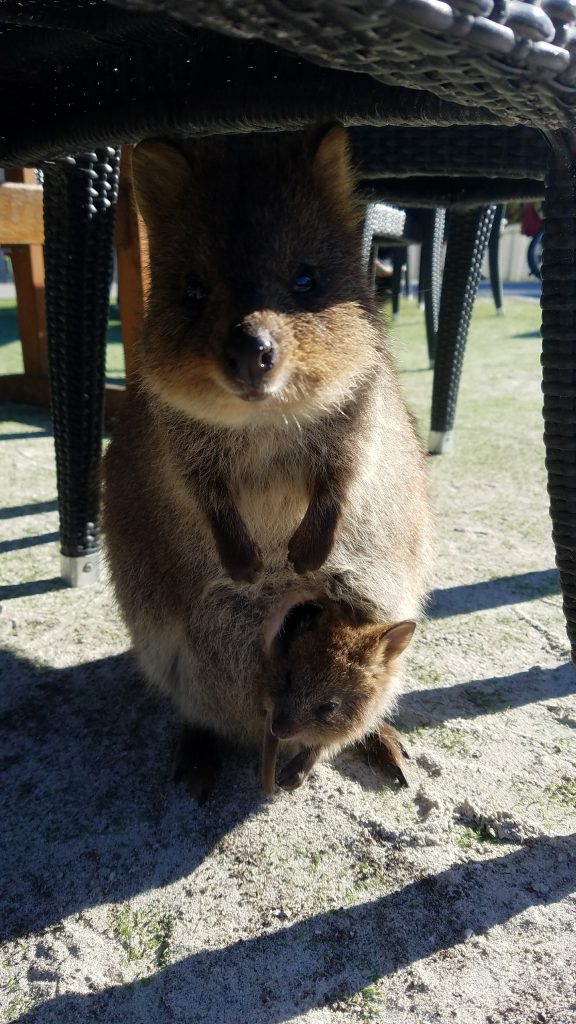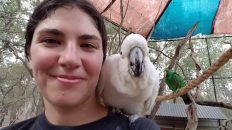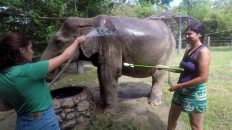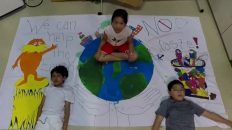It is truly amazing how animals communicate, and how beautiful it is to feel like I had a real experience with them. There is a strong distinction between seeing an animal in a zoo/entertainment cage and connecting with them in the wild. You really get to find out the truth about animals when you respect their boundaries and see them on their terms.
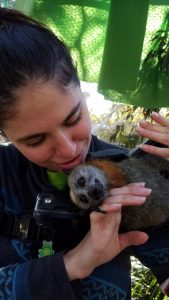 While at the Australia Walkabout Wildlife Sanctuary, I was blessed to learn about and work with some amazing animals. One of the animals that was extremely intriguing was called the “flying fox” which is a large bat. The flying fox is known as a keystone species in Australia – basically, if it becomes extinct, most of the plant and wildlife that Australia is known for will disappear with it. That is because the flying fox is the only animal that pollinates the night flowering gumtrees, also known as eucalyptus trees.
While at the Australia Walkabout Wildlife Sanctuary, I was blessed to learn about and work with some amazing animals. One of the animals that was extremely intriguing was called the “flying fox” which is a large bat. The flying fox is known as a keystone species in Australia – basically, if it becomes extinct, most of the plant and wildlife that Australia is known for will disappear with it. That is because the flying fox is the only animal that pollinates the night flowering gumtrees, also known as eucalyptus trees.
Now without ANY kind of trees, the world will be much worse off. Without the eucalyptus trees, many insects and animals indigenous to Australia will cease to exist – various butterflies, bees, as well as large animals like kangaroos and koalas. Animals, humans included, depend on trees for survival, and without the eucalyptus trees, SO MANY iconic animals that Australia is famous for will no longer be around. I admire Tassin, Gerald, and the work they and their partners do to educate schools, families, and individuals about how amazing and important the flying foxes are to our global ecosystem.
I am starting (and continuing) to learn how backwards many governments are – in many ways, but I will be specifically talking here about how governments don’t truly protect the animals they say they are protecting. Flying foxes have been declared an endangered keystone species, yet farmers are still allowed to shoot them. Koalas are endangered, but only declared endangered in 2 out of the 6 states in Australia – because if the government declares them endangered everywhere, they can’t let their mining friends chop down the koalas environment. Tassin and Gerald fought (and continue to fight) for 10 years to stop a sand mining company from decimating the land in and around the wildlife sanctuary.
CAN WE NOT SEE HOW WE ARE PART OF THE PROBLEM?!?!?!?!?!?!
I cannot stress enough how, although we are (pretty much) the problem, we are also the solution. There are many organizations out there doing great work, like the Walkabout. When I was in Perth visiting my amazing family, I was able to see whales, seals, quokkas, and dolphins in the wild. The tours we went on all stressed the importance of understanding the ways the animals communicate and respecting their boundaries. It was music to my ears when I swam with wild dolphins and one of our guides said “We are going to respect this party of dolphins because they are telling us they are not interested in socializing. We will find others who are more interested in hanging with us.” And guess what? We did!
The lesson below is inspired by the work I did at the wildlife sanctuary. In learning about the flying foxes, the laws helping/hindering them and the koalas, as well as other animals at Australia Walkabout, I realized – I do not know anything about indigenous or endangered animals in New Jersey. I am sure there are plenty of animals that are unique to my state, as well as bees and bats and other animals that need help saving their habitat due to environmental destruction. So I hope this lesson inspires you and your students/children to take the intelligent and inspiring advice of Tassin: get to know animals that are around your home.
As always, please feel free to use my writing journal page for inspiration, contact me with any questions you have about this, or any other lesson, and fill out this short survey if you and your students/children enjoyed it!
Lesson: A Research into Endangered Species
Objective: You will research endangered animals near your home. You will create a research project/presentation about one endangered animal.
Essential Questions:
- What animals live in your environment?
- Which animals are endangered?
- What is being done to protect the animal and their habitat?
- How can you respect animals and their homes?
Materials:
This project can be presented in many different ways, and it all depends on the teacher/ student relationship. Can you trust your students? Do you want them to present all the same way? What technology and resources do you have available to make this presentation successful? Can the students present it in class, with family present, at a school function, etc? Can you take a trip to the library with your students? Do you have a library in your school?
I will list some basic materials that you will need, but this lesson is free to individual interpretation. Be creative, think outside the box, and if you have any questions along the way, please contact me!
- Access to books about animals
- Access to a computer with internet
- Computer printer
- Poster board
- Markers/pencils/pens/crayons
- Scissors
- Tape
- Glue
Procedure: Again, this lesson is open to interpretation. I will describe the procedure I would do in my special needs classroom, and then list some other ways this lesson can be done. Depending on how much time you want/can dedicate to doing this will affect the quality of the work.
My students are not able to independently research yet – some can read, others cannot. What I would do first, is I would research 4 animals that are listed as endangered in New Jersey. This lesson would be a follow up lesson to my first Australia lesson introducing the words ‘indigenous’ and ‘endangered’. Using Google Forms, I would pick 4 endangered animals that they would be familiar with, and have them vote on which animal they want to learn more about.
Once we voted on the animal, I would then go to the library to find books that are simple nonfiction books about the animal. In small groups, my students would be able to explore the pictures and words associated with this animal. For the students that can read and draw, I would have them do so in their writing journal page. I would also bring in tangible representations of the animal – my low students would match the toy to a picture. Another activity I could do would be to have the students learn the body parts of the animal, since that is something we work on year-round.
After the students have gotten familiar with the animal, as well as the words ‘indigenous’ and ‘endangered’, I would go into fun mode, and have students draw large posters that depict some facts and pictures about the animal. Since I have 12 students, I would probably have 4 groups of 3 working on a poster. I would print out some basic facts they learned about the animal, why they are endangered, and assign different roles to students, depending on their ability. Again, depending on ability, students would write, draw, cut, and/or paste items onto the poster.
Once completed, I would organize an awareness march around my school. We would create our own chant, and like I did at the Climate March, I would have my students hold the posters, chant and march around the school educating others about helping this animal. Since we have an outdoor area, we would march inside and outside the school.
If your students could do this version, do it! If you think they want to be challenged more, or research different animals, let them. Please feel free to do both – a presentation and a march. You can assign small groups to work on different animals, or you can research some and let the students individually choose from a list. This can be an ongoing research project, and depending on level, the students can write an essay, do a PowerPoint presentation, a song or dance, music video, even a Public Service Announcement. Any way you and your change-makers can spread more education and awareness about helping animals and their habitat, do it!
If you want to add more social justice into the mix, I would highly suggest watching Zach’s Ceremony. It follows a young Aboriginal boy and his quest to manhood in his culture. Unlike New Zealand, where I saw a lot of tribe pride, I did not see much Aboriginal culture or individuals where I was. Tassin and Gerald’s Walkabout had some amazing historical land artifacts that were thousands of years old, from the Darnkinjung people. I am inspired and fascinated by indigenous culture – it is beautiful they are so connected to the land. There is no ownership, selfishness, or greed – just beauty, respect, appreciation, and care – for the land, the people, and the wildlife that is a part of it.
Obviously, like so many indigenous cultures around the world, their way of life is dying. We (as in white people) have taken their land, pushed them to the brink of extinction. Incorporating this history, or the history of the land, from wherever you are – who lived there a thousand years ago, what they did, how they used the land sustainably, etc. – this would also be a great project to do. I think there should be more white people taking advice from the indigenous elders on how to protect the environment. What do you and your students think?
The above essential questions are meant to delve deep into helping animals and protecting the homes they live in. Any way you would like to do that, please do.
Share with me how you speak for the trees, because if you speak for the trees, you also speak for the birds and the bees and everything, thank you and please!
